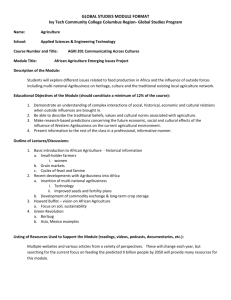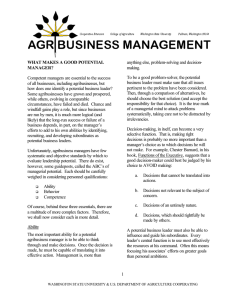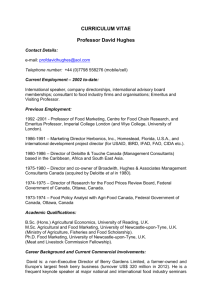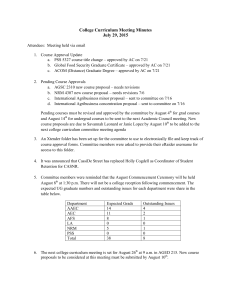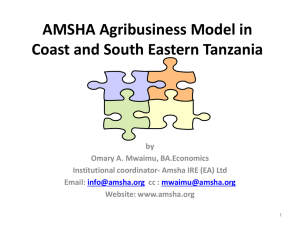Document 12680634
advertisement
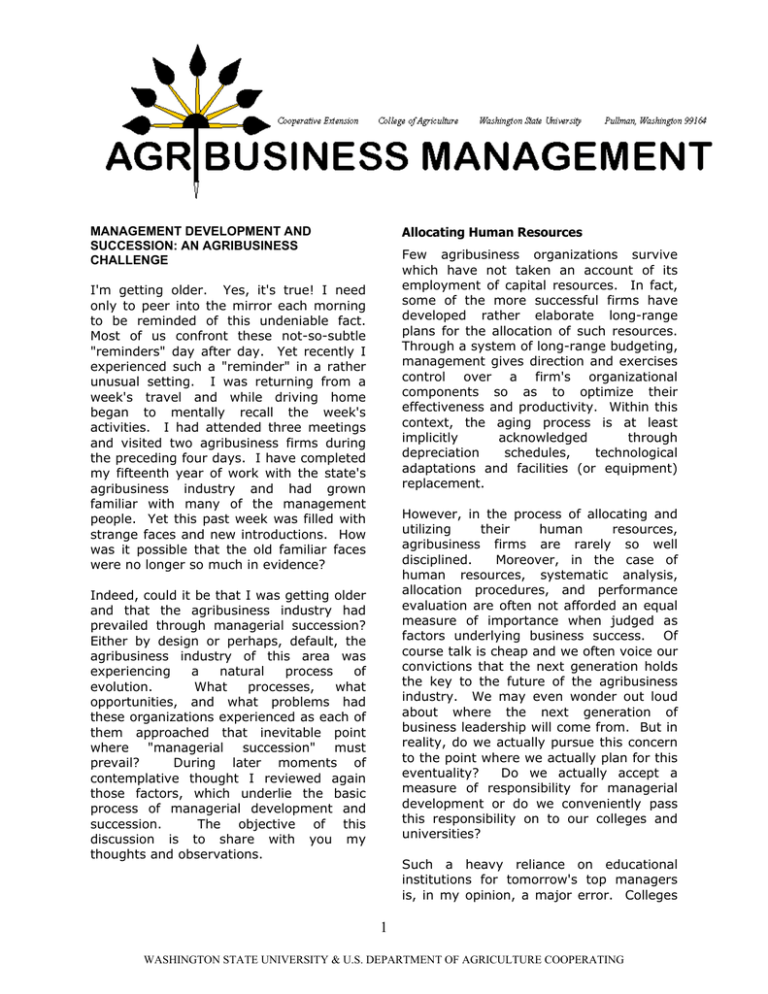
Allocating Human Resources MANAGEMENT DEVELOPMENT AND SUCCESSION: AN AGRIBUSINESS CHALLENGE Few agribusiness organizations survive which have not taken an account of its employment of capital resources. In fact, some of the more successful firms have developed rather elaborate long-range plans for the allocation of such resources. Through a system of long-range budgeting, management gives direction and exercises control over a firm's organizational components so as to optimize their effectiveness and productivity. Within this context, the aging process is at least implicitly acknowledged through depreciation schedules, technological adaptations and facilities (or equipment) replacement. I'm getting older. Yes, it's true! I need only to peer into the mirror each morning to be reminded of this undeniable fact. Most of us confront these not-so-subtle "reminders" day after day. Yet recently I experienced such a "reminder" in a rather unusual setting. I was returning from a week's travel and while driving home began to mentally recall the week's activities. I had attended three meetings and visited two agribusiness firms during the preceding four days. I have completed my fifteenth year of work with the state's agribusiness industry and had grown familiar with many of the management people. Yet this past week was filled with strange faces and new introductions. How was it possible that the old familiar faces were no longer so much in evidence? However, in the process of allocating and utilizing their human resources, agribusiness firms are rarely so well disciplined. Moreover, in the case of human resources, systematic analysis, allocation procedures, and performance evaluation are often not afforded an equal measure of importance when judged as factors underlying business success. Of course talk is cheap and we often voice our convictions that the next generation holds the key to the future of the agribusiness industry. We may even wonder out loud about where the next generation of business leadership will come from. But in reality, do we actually pursue this concern to the point where we actually plan for this eventuality? Do we actually accept a measure of responsibility for managerial development or do we conveniently pass this responsibility on to our colleges and universities? Indeed, could it be that I was getting older and that the agribusiness industry had prevailed through managerial succession? Either by design or perhaps, default, the agribusiness industry of this area was experiencing a natural process of evolution. What processes, what opportunities, and what problems had these organizations experienced as each of them approached that inevitable point where "managerial succession" must prevail? During later moments of contemplative thought I reviewed again those factors, which underlie the basic process of managerial development and succession. The objective of this discussion is to share with you my thoughts and observations. Such a heavy reliance on educational institutions for tomorrow's top managers is, in my opinion, a major error. Colleges 1 WASHINGTON STATE UNIVERSITY & U.S. DEPARTMENT OF AGRICULTURE COOPERATING its own managerial succession. and universities produce excellent employees, but only business can produce top managers. I am not alone in this view. Back as early as 1964, a large number of top industry executives were interviewed regarding those factors that contribute most toward managerial development and succession.1 The findings suggested that: development and Management Perspectives and Expectations Development towards, and succession to, a top management position is often perceived to be little more than an extension of those numerous employeetraining activities that occur throughout the intermediate ranks of management. This is rarely the case. Expanding the professional skills of your accountants, supervisors, foreman, and support staff specialists is rarely ever linked to the desire to uncover a budding chief executive in-the-making. One must, therefore, separate this broader activity from that specifically designed for the "heirapparent." Formal education will be less important to total experience and continuing development as a person approaches the age when top management leadership is in sight. Industry, therefore, must assume the major burden for both developing and making effective use of its maturing executives. Returning now to those new faces I had encountered during that week of travel, I wondered how well the agribusiness industry had accepted this finding. Had the firms consciously planned the use of their human resources in an effort to produce their own future top management? Had they, instead, abandoned this responsibility by "bidding away" bright management prospects from other firms? Or had they totally ignored the question by arguing that the top management slots can always be filled so long as the salaries offered are high enough? Many people fail to realize that at the top of most large organizations can be found a relatively small group of persons. It is not unusual, therefore, that some highly interpersonal relationships develop amongst this small group, much in the same manner as one might associate with much smaller firms. Contrary to common conceptions, a rather informal environment may prevail. Yet it is within this small group setting that the true depth of managerial potential is often tested. At lower levels of the organizational structure, employees often perceive decisions as being governed by conditions imposed by some impersonal and remote source. Only when one reaches the higher echelons of management does one begin to realize that the interplay amongst parties and factions is more personal. Once there, one also gains the impression that executive appraisal of aspirants becomes more realistic and more serious when a direct need exists to fill identifiable, immediate, or prospective positions. This may be contrasted with the picture at middle and lower management levels where the number of people and positions are awesome and hard for one person to digest. To a large degree this explains why most top managers were recognized Quite obviously, this region's agribusiness industry had experienced managerial succession. The appearance of new faces in industry meetings was as much a testimony to this process as it was a recognition of my advancing age. How each firm coped with the experience is unknown. In the knowledge that the process of managerial succession is truly inevitable, I would offer the following thoughts as to the means by which the agribusiness industry could better plan for 1 Bond, F.A., D.A. Leabo, and A.W. Swinyard. “Preparation for Business Leadership: Views of Top Executives.” Michigan Business Reports No. 43, University of Michigan, 1964. 2 as having executive potential quite early in their careers and pains taken to bring them into the "inner sanctum" of top management as quickly as possible. For the agribusiness industry, the lesson is very clear. Don't allow your most promising candidates to languish too long in the lower ranks. Only when they are functionally exposed to the workings at the top can you best judge their true potential. extremely difficult to verify this assertion, particularly in an industry dominated by relatively small firms. Perhaps a more accurate reflection of the agribusiness industry is one that shows position deficiencies at the "second-in-command" level. Many organizations list no administrative positions between the general manager and his supervisory or support staff. When viewing this deficiency, a bright young talented employee is forced to look elsewhere for middle management positions that offer challenge and opportunity. Based solely on my personal observations, I would judge that employee turnover at this level impacts agribusiness firms more significantly than does management turnover at the very top. This very issue often becomes a topic of my discussions with industry employers, many of whom have hired college graduates, only to find them leaving after one or two years for more enticing opportunities elsewhere. Reassess the Options Once your most promising candidates have been identified, a whole barrage of questions confronts the decision-maker. The most common are as follows: 1. For those management positions vacant, or about to be vacated, what is the best allocation of prospective candidates for those positions? 2. What are the current or future requirements for each position? What future changes in the organizations operation are anticipated and how might this affect the requirements? Where does the fault lie for this eventual loss of talent? Have the colleges and universities instilled in these young people a set of expectations that exceed the capacity of the industry? Or, has the industry failed to provide the career development environment needed to retain this young talent? No doubt, both factors play a role, but my only rejoinder is that the employer retains the prime responsibility for retaining its people, while college training is designed more to enhance a person's employability. 3. Do we need to, or want to, change the way the job is done to accommodate the candidate available for the position? 4. What needs of the firm, including its development of management aspirants, can be projected one, five, or even ten years into the future? 5. What effect will the management placement decisions have upon the opportunities, motivation, and development of others on the management team and elsewhere within the firm? Given the perpetual need for management skills in the agribusiness industry, it cannot afford to perform poorly in the marketplace for such talent. An imbalance, in supply and demand for qualified and promising management personnel suggests that the industry must not only employ these people, they must also retain these persons for the duration of the process of management development and succession. Such a management development program cannot concentrate exclusively on the manipulation of individuals via selection, appraisal, and training. In some cases it The Factors of Supply and Demand Most agribusiness managers with whom I'm acquainted generally agree that a shortage of young executive talent remains prevalent throughout the industry. This suggests that there is plenty of room at the top for qualified aspirants. It is 3 may actually be necessary to restructure or mold positions to better fit the aspirants' strengths and weaknesses. Many agribusiness firms are reluctant to improvise in this manner and, therefore, lose those management skills they are so desperately need. provide a credible basis for differentiation amongst several aspiring candidates. More information is needed to show how much of what types of experience provide an acceptable base for a timely movement into upper management ranks. The common presumption is that the man makes the job, i.e., the person's individual talents, abilities, and preferences will most often determine how a job will be done. Yet too often we fail to recognize the contrary relationships, i.e., the job can also make the man. How Rapidly Does the Star Rise? As was noted earlier, for a person to be promoted through the ranks to a top management position, they must move rather rapidly. Most agribusiness firms employ a large number of field-level employees. Insofar as this industry is linked so heavily with production agriculture, field level service and customer contact is critical. It is also understandable that new management recruits must first develop their understanding of the firm's front-line operations before expecting an invitation to join the central office staff. I recall a young undergraduate student with whom I had grown acquainted. Following graduation, he became employed in a mid-sized food processing corporation. During his early period of employment at a supervisory level, he demonstrated many of the same weaknesses he had shown as an undergraduate. He was often late arriving at work and would occasionally disappear from his station in the processing plant for periods of up to one hour. Quite unexpectedly, the plant superintendent suffered a heart attack and could not return to work. The employer telephoned me to ask if I felt this young man was capable of serving as the superintendent. Both the employer and I expressed some reluctance, but the packing season was underway and quick action was required. The young man was promoted into the position. At the conclusion of the season, I revisited the plant to discover that the young man had excelled in his new position of responsibility. The challenges of the job had truly made the man. He had become more dependable and self-confident. He had worked hard and rapidly gained the respect of his colleagues, most of whom were 10 to 20 years his senior. Yet to the new recruit, time-in-rank is a very sensitive issue. It is very important for persons so positioned to perceive a clear sequence of advancement opportunities. Moreover, either horizontal or vertical advancement within this perceived structure must be timely. Such movement is essential if the trainee is to "arrive" equipped with an appropriate range of experiences to draw on and at an age when they have the remaining vitality and enthusiasm to continue to perform at an accelerated level. This process places a premium upon the early discovery of managerial potentials and minimum delays in advancements. For management, the success and rapid advancement of relatively young employees raise some important questions. Most would agree that proven abilities and a demonstrated willingness to apply oneself can shorten the time necessary for learning the essentials of a job, but how, and how much, is somewhat unclear. Knowledge of the business and of general managerial practices remains a basic requirement, but often does not The "Crown Prince" Syndrome The issue of the so-called "crown prince" is largely academic since the facts would suggest that management must select "crown princes" whether they like the term's connotations or not. As has been 4 suggested above, it is both necessary and desirable that agribusiness firms identify top management candidates early in their careers so that observation, preparation, and grooming can be accomplished within the limited time period available. This process of early selection inevitably raises an internal problem, i.e., those so selected are few, but happy, while those not selected are more numerous and less happy. management development program, i.e., that designed as a program for all management personnel and that more carefully focused as a specific executive development system. In Search of Distinguishing Characteristics Needless to say, the process of selecting successors for top management positions in the agribusiness industry is plagued with the difficulty of finding objective differences amongst large numbers of candidates. Too often, trivial and sometimes superficial differences determine the choice. In the absence of more solid criteria, these differences take on great weight because of the decisionmakers' need to establish some differentiation and to rationalize their selections. My own observations would suggest that the manner by which a general manager differentiates the characteristics of his co-workers bears a relationship to the operational effectiveness of his own performance. More simply stated, the chief executive will seek to identify and cultivate those characteristics in people that he feels contributed towards his own success. Lacking more rigorous or ideal methods for identification of executive talent, and lacking evidence in support of the accuracy of long-term predictions relating to individual performance, the decisionmakers must still depend upon their own personal assessments. Given the unstructured environment thereby created, the following factors sometimes come into play: To cope with the frustrations of those not selected, it is important to establish a procedure within which those who may have been overlooked will be assured another opportunity to be considered, if their performance merits it. Such a procedure must not be comprised of empty promises or false hopes. In an attempt to blunt the sharp edges of this inevitable conflict, management sometimes mistakenly resorts to a variety of subterfuges. By far the most common subterfuge is that wherein persons not selected as crown princes are anointed with innocuous titles as a substitute for real internal influence. In my opinion, this practice is of doubtful value. Within such a practice, management is merely perpetuating a sense of self-delusion and hiding from its responsibility. Any management practices, which emphasize the early identification of management talent, will raise the specter of the "crown prince." Once top management spots this person, he or she moves into a different orbit (often referred to as the fast track) in which standard procedures of the normal management development systems are superseded by other provisions. Such provisions are usually more encompassing in scope, but less structured in practice. They are designed to enhance the selected person's visibility with senior management. It is at this point where top management takes control in order to test and groom the candidates. As such, there are two separate systems within the firm's 1. Being in the Right Place at the Right Time - to be sure, individual destinies are not fully controlled by either the individual or the employer. Businesses fail, executives have heart attacks, mergers are undertaken but frustrated by anti-trust action, inflation occurs, technology induces sudden changes, and new competitors appear in the market. Such events have considerable unplanned influence on the success criteria. They may even 5 have a direct bearing upon evaluation of individuals who, rightly or wrongly, were destined for rapid advancement in an organization. draw disproportionate attention, and loom more prominently in the perceptive eyes of the decisionmakers, if he is assigned to a task, unit, or function that is distinctly different from that which is customary or conventional for the firm. 2. Accidental Versus Planned Discovery at a premium in most firms are those positions that provide a good opportunity for a management aspirant to have sufficient weight and range of responsibility to test thoroughly his own executive talents. However, such "gate-opening" positions are not always available, particularly in smaller agribusiness firms. In such an absence, accidental discovery may prevail. The difference between more and less well planned management development and succession programs is often the difference between accidental or fortuitous discovery of talent and the continuous planned campaign of discovery. 6. Replacing a Bad Apple - one way of enhancing one's prospects, it is sometimes argued, is to succeed in a job that was badly performed by your predecessor. It is presumed that the relief at getting rid of the "bad apple" will be so pervasive that it will add a "glow" to the accomplishments of any person acting as a replacement. 7. Principle of Misplaced Modesty - this suggests that self-effacement is not altogether appropriate for the aspiring executive. This does not mean that he exaggerates his accomplishments, hides his mistakes, aspires to infallibility, or derogates his peers. It does mean that he accepts the fact that, in addition to doing a good job, it is important that "somebody up there knows me." 3. Enhanced Visibility - that industry cliché which suggests that aspiring persons should "hitch their wagon to a star" sometimes comes into play. It holds that if a previous superior, whom you have favorably impressed, moves up in the organization, your chances of following him up the ladder are increased. A similar thought suggests that one way to enhance your visibility is to concentrate your work in smaller units of an organization whereby the relative merits of your performance are more likely to be observed. 8. Principle of "Performance Paramountcy" - suggests that, in the final analysis, demonstrated performance carries more weight than connections. This principle contradicts the age-old complaint, "It's not what you know, but who you know that counts." So, it would appear that while it may not hurt to be married to the boss's daughter, to get ahead one must be able to produce at least as well as the competition. 4. Hew to the Line Principle - reflects a consensus that, where comparisons and choices are made, the odds favor the man on the line. The assertion is that a good staff man can be most appreciated for his specialized contribution to the work of others, but the real "results" are tied more closely to line positions and, thereby, more impressive to the chief executive. Ken D. Duft Extension Marketing Economist 5. The New Look Principle - this principle suggests that an individual is likely to 6

